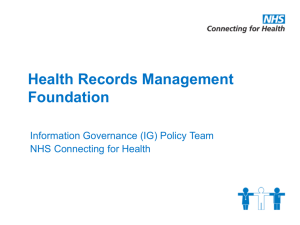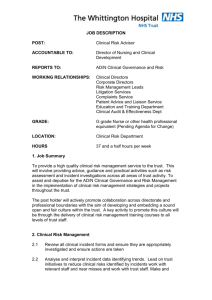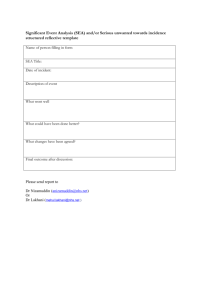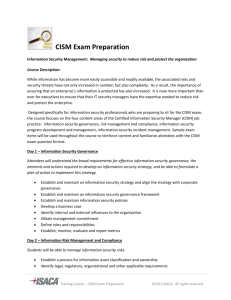Risk Management
advertisement
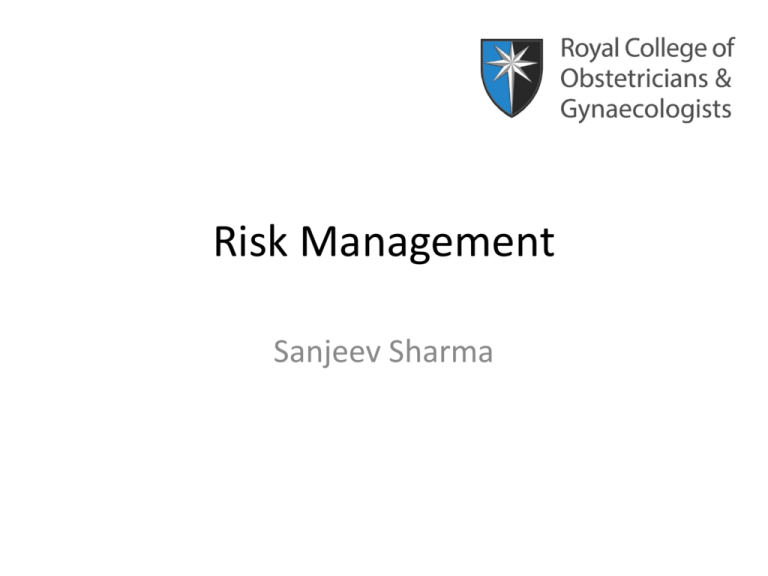
Risk Management Sanjeev Sharma Clinical Governance Clinical Governance (NeLH- Health Management) What is Clinical Governance? (1) Clinical Governance is: • “A framework through which NHS organisations are accountable for continously improving the quality of their services and safeguarding high standards of care by creating an environment in which clinical care will flourish” (DoH, 1999) Clinical Governance (NeLH- Health Management) What is Clinical Governance? (2) The foundations of clinical governance are: • The setting of realistic and evidence-based standards of care • The monitoring of performance against these standards • The implementation of change to ensure that these standards are reached and, if possible, exceeded Clinical Governance (NeLH- Health Management) What is Clinical Governance? (3) • • • • • • • • • • The tools to achieve these foundations include: Multidisciplinary clinical audit Clinical effectiveness Research & development Lifelong learning Risk management & critical incident reporting Evidence-based medicine/ practice Guidelines, pathways and protocols Service accreditation Individual appraisal and assessment Information management Clinical Governance (NeLH- Health Management) Why is it important? • Clinical governance is explicitly reflected in the responsibilities and management of NHS Trusts • Chief Executives have the ultimate responsibility for assuring the quality of the services provided by their NHS Trust (Health Act, 1999) • The Health Act also established the Commission for Health Improvement (CHI) to help improve the quality of health care in the NHS by investigating the quality of healthcare in Trusts and by providing advice on quality health care Clinical Governance (NeLH- Health Management) What are the benefits? • Clinical governance improves not only the quality of patient care, but also efficiency and procedures • It can therefore both enhance patient satisfaction and reduce costs Clinical Governance (NeLH- Health Management) Risk Management What is risk? A risk is the likelihood of a hazard happening and the impact it could have. Risk is defined as “ the possibility of incurring misfortune or loss” and can be associated with people ( patients, visitors and staff ), buildings and estate, equipment and consumables, systems and management. Risk Management Risk The likelihood of a hazard happening and the impact it could have. Hazard The potential for harm. Hazard ? • Something with the potential to cause harm Risk ? The Likelihood of harm occurring Risk Management What is risk Management? It is the process of assessing risks and taking steps to either eliminate or to reduce them ( as far as is reasonably practicable) by introducing control measures. Risk Management • Providing health is a risky business. • Risks are associated with environment, procedures, interventions and treatments. • Risks can be to • Patients • The health care staff • The health care provider organization • Risk management is about providing care safely. • It aims to develop good practice and reduce the likelihood of harmful incidents happening. • All risks need to be minimized as a part of quality and safety agenda. Risk Management Why do risk management? • A number of widely publicised high profile cases. • 850,000 adverse incidents per year – 1/3 leading to disability or death1. • 50% avoidable according to US studies. • £2 billion/year in additional in-patient stays. • £400 million in compensation. 1 Vincent C, BMA conference, March 2000 Risk management Why do things go wrong? Organisational Cultural Weak leadership Education and research not valued Cliques and factions No strategies Poor management Poor communication Sparse infrastructure Individual External Defensive Fortress mentality Little collaboration Poor motivation Poor team working Poor attitude Lack of skills Risk Management What is Risk Management Strategy? The risk management strategy integrates all aspects of governance and risk to ensure quality and safety of NHS organizations. Each NHS Trust must have a strategy for governance and risk. Risk Management What is Risk Management Strategy? • Focus on the system rather than the individual incident. • It is anticipatory not reactive in emphasis. • Significant event audit and adverse incident reporting therefore supports risk management by monitoring it. Risk Management Care Quality Commission It is responsible for health and social care in England. NHS Litigation Authority ( NHSLA ) It is responsible for all clinical and non clinical negligence claims against NHS bodies in England. National Patient Safety agency ( NPSA ) It is responsible for for improvement of patient safety. All patients safety incidents are reported to NPSA. Risk Management The Risk Register A risk register is a log or database that lists every type of risk that has occurred within the Trust. Risk Management Principal areas of concern • • • • Diagnosis Prescribing Communications Organisational change Risk Management Incident Reporting All NHS staff have a professional and ethical responsibility to complete a Trust Incident Form after any and every incident that occurs that potentially compromises patient safety, or safety of the staff. It is to understand what happened, why it happened, learn from the incident to prevent future events. Risk Management Possible reportable incidents Non-clinical • • • • • • • • • Maintenance of equipment/ buildings The hostile patient Waste management Infection control Fire safety Employers liability Message handling Staff turn-over Security of information Risk management Benefits of Incident reporting • Better allocation of resources. • More informed decision-making. • Greater compliance with legislation. • Greater transparency and accessibility to external review. Risk management Benefits of Incident reporting • Better outcomes and patient satisfaction (improved quality of service). • Ability to learn from mistakes. • Reduced costs of litigation and compensation. • Better public image. Incident Reporting Risk Management Incident Report What information to be included in the incident form? – – – – Date of incident. Time and place of incident. Personal details of those involved. A brief description of the nature of the event. Three copies Nine Sections (1) Date/Time/Location (2) Person Affected (3) Injury/Outcome (4) Type of incident & Severity (5) Details of Occurrence (6) Action taken at the time of incident (7) Who completed the report (8) Subsequent action Risk Management Record Keeping What is a record? A record is recorded information in any format that is created, received, or maintained by the Trust and kept as evidence of healthcare treatment for a patient. Risk Management Good Record keeping • • • • Gives accurate accounts of treatment. Allows better communication between team members. Has ability to detect changing situations early. Guarantee of safe and quality care, Risk Management Good Record Keeping Well organised and Easily Located Contain Factual Information Only Written Within 24 hours Additions/Changes clearly marked and signed A Good Patient Record System Shows the Correct Date and Time Written Clearly and Cannot be Erased Patient Understands Language Easy to Read and Make Copies Risk Management Bad Record Keeping Staff not Trained Properly Record not saved Properly Details not Checked before being Processed Bad Patient Record System Records not Produced Quickly Enough Key Information Missing Risk Management How is risk Calculated? It is measured in terms of likelihood and consequences and modified by the frequency of the activity that may lead to risk. Risk Management Calculation of Risk Existing level of risk = Severity ( as a measure of magnitude) X Likelihood (as a measure of frequency ) Risk Assessment Management of Health and Safety at Work Regulations These regulations set legal requirements for which Directors and Managers can be held personally responsible Risk Assessment is basically a 5-stage process which consists of the following steps: Identify Hazards Evaluate the Risks Eliminate the Hazards if possible Minimise (control) the risk Monitor/review periodically Risk Management Establish Likelihood Multiply Likelihood X Impact Rating Establish Impact Category ALARP PRINCIPLE INTOLERABLE REGION Risk cannot be justified Smoking Driving a car ALARP REGION Risk is undertaken only if a benefit is desired) and steps must be taken to reduce the risk is “As Low As Reasonably Practical (ALARP) Taking the contraceptive pill Being struck by lightning ACCEPTABLE REGION Risk reduction not likely to be required Being struck by a meteorite Risk Management The components of quality Attitude Audit Risk Management Patient focus Life-time learning Systematic care Valuing practitioners Supporting innovation From the NHS Plan Relationship to critical event audit Significant event audit Risk Management Three Types of Risk Uncertaintybased risk Opportunitybased risk Hazard-based risk Error Types Basic error types Intended actions Violations Mistakes Routine, reasoned, reckless and malicious: we always break that rule Rule or knowledge based errors: don’t know something is wrong Unsafe acts Unintended actions Lapses Slips Skill based errors, memory failures: forgetful Skill based errors attention failures: distracted, tired Adapted from NPSA and Reason



